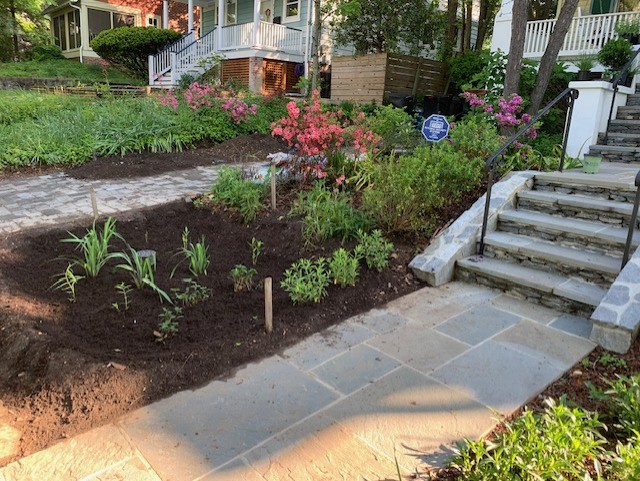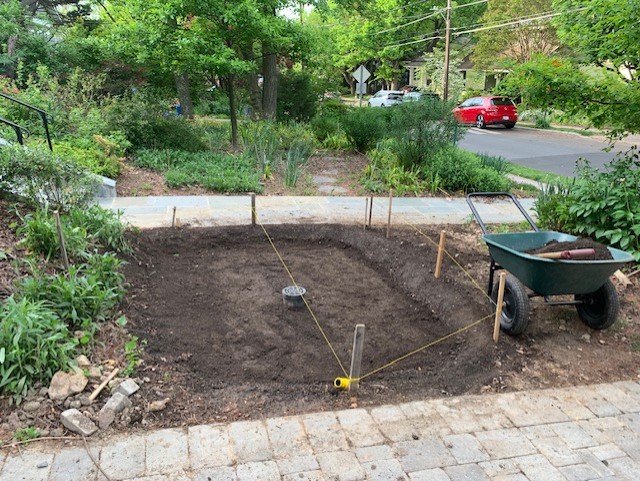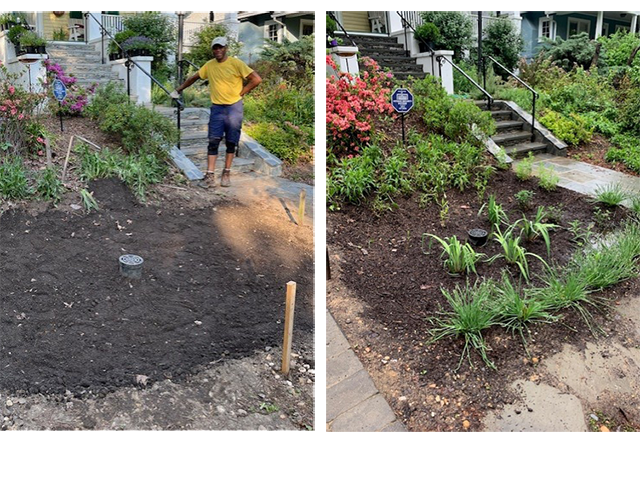
By Artie Harris, Chair, Montgomery County Planning Board
This is the story of my rain garden adventure in the front yard of my family’s Takoma Park home.
Every time there was a big rain, water rushed down our driveway into the street, joining with runoff from other houses in a fast-flowing gush along the curb. Since our house is on a hill, stormwater has never caused us any problems, but we knew our downstream neighbors suffered from flooded basements. We also knew the result of all this cumulative discharge was harmful to the beloved Chesapeake Bay.
Many Montgomery County homes have a similar problem, but in our case, it was especially obvious because we had a gravel driveway. Over many years, so much of the gravel swept into the street during rains that it exposed the dirt and concrete underneath.
Time for a new driveway! But what kind? Paving with concrete or asphalt would add one more impermeable surface. Eco-friendly solutions like permeable pavers seemed like an obvious choice, but we learned the level of slope of our driveway was such that rain would not have time to absorb and would still end up in the street.
A rain garden to help capture and filter rainwater on our property seemed like a great part of our solution. My wife Susy was already adding native plants that benefit pollinators in our yard, so this was a natural extension of our efforts. (Check out the cool concept of the Homegrown National Park.)
The rain garden had to fit between the driveway and lead sidewalk and between the base of a slope and a stone walking path— 10 feet (N/S) by 8 feet (E/W). We created a bowl shape in that area to hold water, but because the ground sloped in two directions, we needed to build up a berm to keep “the water in the tub,” so to speak, until it had time to absorb into the ground. Montgomery Parks staff pointed us to a wealth of how-to information online, including lists of plants that Susy had a lot of fun dreaming about. In the end, she decided on native blue flag irises, chelones (turtleheads) and swamp milkweed for the ponding areas; asters for average moisture areas; black-eyed Susans for dryer areas; and blue-eyed grasses for the berm.
While installing pavers for the driveway, we connected many of the downspouts of our house along with a trench drain at the top of the driveway to an underground pipe that terminated at an underground drywell in the rain garden. The drywell is basically a rain barrel with holes about 2 feet in diameter and 3 feet deep with an overflow pipe at the top. We surrounded it with about a foot of gravel to effectively create a larger drywell and wrapped that assembly in filter fabric.
While the contractor installed the driveway, piping, drywell assembly and filter fabric, the rest was a do-it-yourself project. We created the “bathtub”, augmented the existing clay soil to make it rich enough, created the berm, installed the plants, and put in a 2-inch top layer of mulch to keep soil moist during dry periods and to minimize weed production. I spent the better part of a weekend shoveling and mixing soil, supported with some ibuprofen and a few hours of much appreciated paid labor.
The project was substantially complete just hours before a two-day rainfall. When the rain ended, there were a couple inches of water pooled in the rain garden and, a few hours after the rain had stopped, the water had absorbed. It was working as planned! (I had done a mini percolation test a week earlier—I dug a hole in the natural soils and filled it with water and observed how fast the water flowed out; based on the results I felt comfortable that water would flow out of the rain garden within a reasonable amount of time.)
If you have room on your property, I encourage you to install a rain garden, drywell, or both. Montgomery County has incentives for homeowners to install rain gardens through the RainScapes Rewards Rebate program. While the residents of Takoma Park, Rockville and Gaithersburg cannot participate in this program, they can access other savings. In our case, our improvements make us eligible for discounts on our stormwater management bill.
Our project turned out to be pretty complex, but yours doesn’t have to be. In addition to a rain garden design without a drywell, you can opt for a simpler conservation garden that can also slow down and soak up stormwater runoff. Montgomery County’s RainScapes website is a great place to start your journey.
As for our family, we are thrilled to replace the dread of water, gravel, and sediment being washed into the street with the joy of seeing butterflies and bees in our new garden and the significant reduction of stormwater runoff from our property.

About the author
Before his appointment as Planning Board Chair, Artie Harris was the vice president of real estate at Montgomery Housing Partnership, Inc. (MHP), a nonprofit real estate development organization based in Silver Spring, MD, that creates affordable communities in Montgomery County and surrounding jurisdictions. Previously, Harris was a vice president at Bozzuto Development Company, where he led teams developing market-rate and mixed-income housing projects across the Washington, DC region and beyond. He holds a master’s degree in business administration from Stanford University and a master’s degree in civil engineering from Purdue University.

